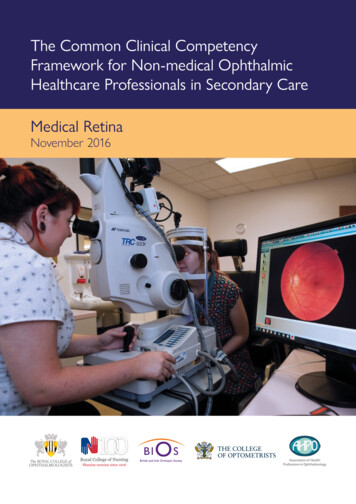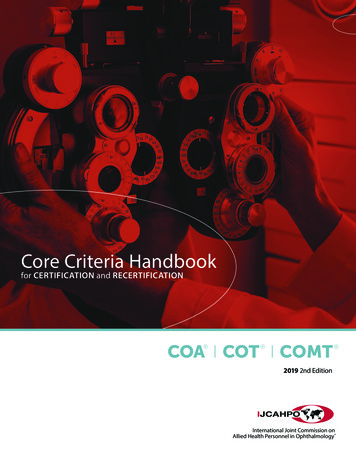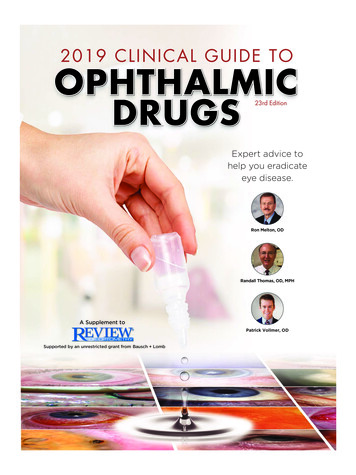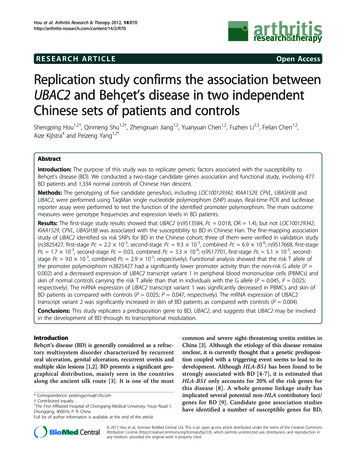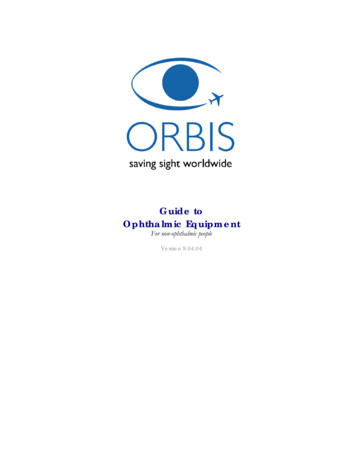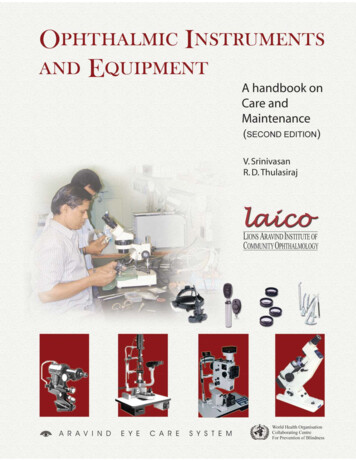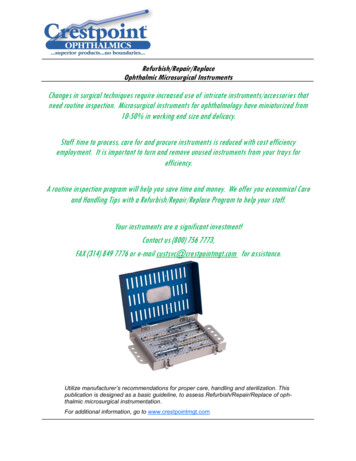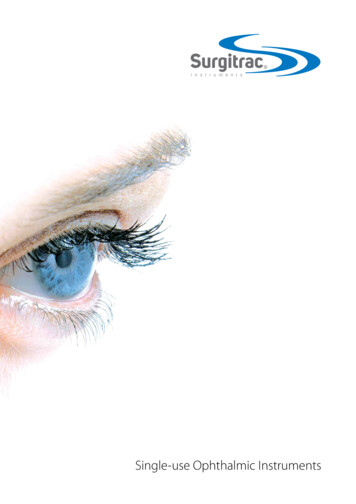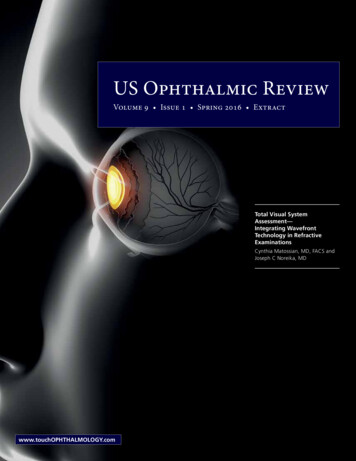
Transcription
US Ophthalmic ReviewVolume 9 Issue 1 Spring 2016 ExtractTotal Visual SystemAssessment—Integrating WavefrontTechnology in RefractiveExaminationsCynthia Matossian, MD, FACS andJoseph C Noreika, MDwww.touchOPHTHALMOLOGY.com
DiagnosisTotal Visual System Assessment—Integrating Wavefront Technology in Refractive ExaminationsCynthia Matossian, MD, FACS 1 and Joseph C Noreika, MD 21. Matossian Eye Associates, Pennington, New Jersey, US; 2. Excellence In Eyecare Inc., Medina, Ohio, USAbstractCurrent trends and recent legislative changes have increased the pressure to control healthcare costs, especially those associated with runningophthalmic practices. These factors have driven practice consolidation, reduced consultation times, increased use of electronic health recordsystems, and encouraged more meaningful use of technology. At the same time, patient expectations and standards of clinical care are both rising.This climate could discourage investment in new technology and encourage increased intensity of service, with higher patient throughput at the riskof decreased quality of care. This situation emphasizes the traditional value proposition model in which quality, time, and cost are closely interrelated;decreasing time and/or cost negatively affects quality. The use of wavefront technology and the development of the XFractionSM process, however,have challenged this model. Using the Optical Path Difference III (OPD-III) and Total Refractive System-5100 (TRS-5100), substantially greater amountsof higher-quality data are derived from ophthalmologic patients in shorter examination times than with other refraction instruments. Their useprovides an improved patient experience, greater patient throughput, and more time for the physician to precisely tailor the treatment to match thecondition. In practices that have acquired the OPD-III, it has become indispensable in vetting patients for intraocular lenses (IOLs), advanced cornealrefractive surgery, and preoperative identification of various optical issues. Experience at an example practice shows that optional use of OPD-IIIexamination is high and it is increasing, despite patients incurring out-of-pocket fees. XFraction technology, therefore, is a route to more satisfiedpatients, greater efficiency, and profitability; and it can help ophthalmic practices thrive amid increasingly adverse commercial and medical pressures.KeywordsOptical path diagnostics, wavefront optimized refraction, total visual assessment, intraocular lens selection, sustainability, value proposition,return on investmentDisclosure: Cynthia Matossian, MD, FACS, and Joseph C Noreika, MD, have nothing to disclose in relation to this article.Acknowledgements: Medical writing assistance was provided by James Gilbart at Touch Medical Media, London, and funded by Marco.Open Access: This article is published under the Creative Commons Attribution Noncommercial License, which permits any noncommercial use, distribution, adaptation, andreproduction provided the original author(s) and source are given appropriate credit.Received: February 22, 2016 Accepted: March 16, 2016 Citation: US Ophthalmic Review, 2016;9(1):41–5Correspondence: Joseph C Noreika, MD, Excellence In Eyecare, Inc., 3609 Medina Road, Medina, OH 44256, US. E: jcnmd@aol.com; Cynthia Matossian, MD, FACS, Two CapitalWay, Suite 326, Pennington, NJ 08534. E: cmatossian@matossianeye.comSupport: The publication of this article was supported by Marco. The views and opinions expressed are those of the authors and not necessarily those of Marco.This review examines how the adoption of refractive wavefront technologycan help address the challenges, and promote the success of practicescompeting in an increasingly demanding regulatory and economicenvironment. In ophthalmology there is an increased need for efficiencyand productivity, beginning with the collection of meaningful patient data.A new value proposition has evolved to meet the demands of changingmarket conditions. This proposition helps define and protect the value ofthe practice, drives the decision to acquire new technology and illuminates theprocedural changes that add value for the patient, the ophthalmologist, andthe business. Devices acquired by a practice need to meet this new paradigm.The metrics proposed below delineate this purchase decision process.Increased spending mandated by the Affordable Care Act has enhancedaccess to medical care for people who previously had no medical insurance.1TOUC H MED ICA L MEDIASignificant consolidation of the insurance industry has resulted. The cost ofinsurance policies and out-of-pocket costs to the patient have increased.As a consequence, there is increasing pressure to control these outlays.Practices may respond to the downward pressure on reimbursementby reducing investment. Recent legislation, including the repeal of theMedicare Sustainable Growth Rate (SGR) has shifted the payment modelfrom fee-for-service to value and quality.2–5 Medicare payments are nowdetermined by the quality and efficiency of rendered care.In all areas of medicine, including eye care, there is an impetus toutilize electronic medical record technology in ‘meaningful’ ways.6–8 Themeaningful use of electronic health record (EHR) systems aims to engagepatients in their healthcare, improve coordination among caregivers andenhance public health. Diagnostic instruments that functionally integrate3
DiagnosisTable 1: Categories of Return on Investment forOphthalmic Technology and Related BenefitsCategory of Returnon InvestmentRelated BenefitsDirectProcedures directly reimbursedIndirectImproved efficiencyIncreased productivityDecreased cost per examIncreased number of examsAdditionalEHR connectivityRx accuracy/decreased re-makesTriage speedDiagnostic speedcosts include intraocular lenses, surgical devices and supplies, smallinstruments, pharmaceuticals, and utilities.14,15 A sunk cost, the purchaseof new technology also incurs the ongoing cost of its maintenance.Depending on the terms of purchase, this maintenance fee may be a fixedor variable cost.A practice will typically finance the purchase of expensive technology.16 Thenew equipment must have reasonable initial and operational costs, relativeto the benefits it provides. Benefits can include acquisition of additionalpertinent data to enhance diagnostic acumen, reduced time to an accuratediagnosis, ease of use, faster staff adoption, reliability, and timely supportfrom the manufacturer. It is also desirable that the technology be appealingand impressive to patients and their caregivers.5,13,17–19Diagnostic accuracyImprove IOL matching (selection)Increased patient satisfactionRetention and ReferralsImproved patient experienceQuicker and more effective patient educationStaff retentionPractice differentiationMore competitive in joining plans (ACO, etc.)ACO accountable care organization; EHR electronic health records; IOL intraocularlens; Rx treatment.with EHR systems enable sharing of data and images, seamlesslypromoting patient interaction and practice efficiency.There is a trend toward consolidation of providers into group practicessuch as ‘accountable care organizations.’9 This has led to organizationsexhibiting greater power to negotiate costs with contracted providers.A separate challenge is associated with the conversion from theInternational Classification of Diseases-9 (ICD-9), which has been usedsince 1975, to ICD-10, which was implemented in October 2015.10–12A common theme of these changes is the need for capture, documentation,and sharing of complete and reliable data at the point of care.The Business of OphthalmologyThere is a dialectic between the acquisition and maintenance costs ofnew technology and healthcare economics.13 One approach is to purchasespecific devices that can diagnose or treat as many patients as possibleto reduce the per-patient cost of the investment. An important dilemmainvolves the question of whether to adopt the new technology early orwait until the technology is more widely disseminated and possibly lessexpensive. Analysis of a technology’s true cost must consider the valueadded for the patient by expansion of the ophthalmologist’s diagnosticcapabilities. Because of the decreasing reimbursement, the availability andutility of the technology is paramount to ensure a return on investment (ROI).The profitability of medical practice is dictated by the number of patientsexamined, the income generated per patient as determined by the intensityof services provided, and the costs associated with providing theseservices. The enhanced productivity of integrated wavefront analysis anddigital refractive technology embraces all three economic parameters.Fixed costs including staff, rent, leases, and office equipment accountfor 70% or more of total practice expenditures. Additional variable4Quality of outcome is not determined by merely asserting the noveltyof an instrument or therapeutic modality. It is necessary to ask whatincremental benefit might be expected relative to performance and costof this technology when compared to competing products. Outcomesmust be equal or superior and costs competitive, or at least justifiable.Ophthalmologists face increasing challenges to ensure new technologywill support this value proposition.20,21 The acquisition of new technologyin any ophthalmic practice must also provide a ROI. In ophthalmicpractices, ROIs fall into ‘direct’, ‘indirect’, and ‘additional’ categories, eachbringing benefits via different routes. These different ROIs and associatedbenefits are delineated in Table 1.Claims that technology saves money are not sufficient to justify purchase.Potential savings and economies must be clearly demonstrable andeasily understood. Consideration of price, although important, must notcompromise data quality or diminish the patient’s overall experience.Demographics are changing patient expectations. Standards definingclinical efficiency have been raised progressively and exponentiallythrough the greatest, the boomer, and the millennial generations. Thesechanges are increasing the demand for, and sophistication of, services.22,23Patient expectations must be managed to align realistic therapeuticpossibilities and achievable quality metrics. Recognition and discussionof pre-existing conditions that impact a procedure’s outcome mustoccur before surgery to avoid post-operative dissatisfaction inaccuratelyattributed to technique or choice of therapy.24–26,27The Value Proposition of the Optical PathDifference Scan Technology and ProcessA transformative technology’s value is defined by its intersection withquality, speed, ease of use, and cost delivered to the ophthalmologist,the practice, and most importantly, the patient.28 Each value proposition isunique and can be graphically represented by the Venn diagram in Figure 1.Value is found at the intersection of the three circles.XFraction and the OPD-III Aberrometer/CornealTopographerRecently, the traditional value proposition model has been challenged.The fusion of Optical Path Diagnostics (OPD-III) and wavefront-optimizedrefraction (Total Refractive System-5100; TRS-5100) into a diagnostic processtermed ‘XFractionSM’ (XF) challenges the ‘equilibrated compromise’ ofthe traditional model. The dynamics of the value proposition representedby the Venn diagram has dramatically shifted. XF increases speed andUS OPH TH A LMIC RE VIE W
Integrating Wavefront Technology in Refractive Examinationsquantity of data capture, while simultaneously improving diagnosticaccuracy. The acquisition cost of the data provided is lowered.29,30The XF process combines auto-lensometery, integrated wavefrontaberrometry, and digital refraction technologies. Using a process distinctfrom that employed by competing models, data collated from the threetechnologies are integrated. An exemplary platform for the XF process is theEPIC workstation. This installation combines two devices. The first is the OPDScan III, which combines five functionalities: autorefraction, keratometry,wavefront aberrometry, topography, and pupilometry. The second deviceis the TRS-5100, an automated, programmable digital refractor utilizing aspace-saving chart system within the EPIC’s overall design. In comparisonwith other available offerings, the multimodality EPIC workstation providesa compact footprint, yielding more high-quality data points, thus enablingenhanced point-of-care decision-making. The devices work on the samecompact platform table; the collected data is passed seamlessly to theclinic’s EHR. Experience shows that, by completely integrating the componentdevices, five to seven minutes per exam are saved. Both diagnostic andeducational capabilities of the OPD produce significant benefit and value toan ophthalmic practice, affecting the decision to adopt this new wavefrontoptimized refraction technology, as summarized in Figure 2.The OPD-III aberrometer/corneal analyzer provides important data for allpatients, especially those considering cataract surgery. The integration oftopography, wavefront aberrometry, and pupilometry in one instrumentwith a single registration of eye position permits a reliable analysis of thealignment of the elements comprising the patient’s optical system. Anglekappa is measured preoperatively and its acquisition can determine thefeasibility of multifocal implantation. Other important parameters include:the amount, pattern, and location of astigmatism; pupil size in mesopicand photopic conditions; type, amount, and location of high-orderaberrations; and, a point spread function display of current and expectedaberrations after cataract removal based on pre-existing corneal factors.In addition, the OPD captures and displays placido disc mires for analysisof corneal surface abnormalities. Tear film quality and instability indicatethe possibility of pre-existing disease.31–38 Retro-illumination capabilityallows discovery of tilted or decentered intraocular lenses (IOLs) aswell as cortical and subcapsular changes of the crystalline lens.18,29–31Because the OPD system interconnects with most EHR systems, dataare transferred quickly and the results of the diagnostic studies can begraphically displayed across many image formats.Training strategies ensure rapid staff learning and proficiency. Althoughsophisticated, the technology is user friendly and ophthalmologistsreport smooth and predictable staff acceptance. Professionally producedwebinars that can be accessed at the viewer’s convenience heightenthe learning experience. Staff with little or no experience can be trainedquickly to perform the testing and refractive functions of the EPIC.Figure 1: The Traditional Equilibrium of Quality, Speed,and Cost—A Relationship that is Changed by WavefrontOptimized Refraction (XFraction)KNOWLEDGEdata & decision TefficiencyTRADITIONAL- to patientexperience- to practiceprofitsXFRACTION(Wavefront enhanced refraction)Figure 2: Flow Chart of Factors Affecting the Decision byan Ophthalmic Practice to Adopt Wavefront-optimizedRefraction TechnologyOphthalmic practice withoutwavefront-optimized refraction processContinue with existing facilitiesdue to: Perceived cost Lack of awareness Unwillingness to adopt or learnnew technologyInvest in new technology - financialand limited training time outlayare justified by large gains in: Diagnostic capabilities Patient throughput Patient experiencePatients receive less comprehensiveor informative exams - may need tomove between instruments Faster discernment of irregulararastigmatisms (HOAs) and superiorunderstanding of optical pathintegrity not possible Less time to discuss IOL treatmentissues and ensure understanding Patients may be less satisfied andmay not re commend the practice Revenues may declineEye assessment faster - capturingextensive data - more precise diagnosesand better preparation for IOL surgery More time available for discussion Reports uploaded into EMR Patients are partners in diagnosticvalidation - more satisfied with greaterunderstanding Patients more likely to recommendpractice/procedures Outcomes improved Revenues likely to increaseEMR electronic medical records; HOAs higher order aberrations, IOLs intraocular lenses.XFraction in the Ophthalmic Practicewhen it is needed. In the exam room, its well-organized screens projectimages to educate the patient, allowing the physician to concentrate onthe nuances of the therapy being considered. This saves chair time, whileadding value to the patient experience. The value proposition of the EPICworkstation has similarities to those of other innovative and life-changingtechnologies that are now in widespread public use.To succeed, today’s ophthalmic practices feature efficiency as a keyoperating principle. The use of wavefront optimized refraction/XFaugments and complements multiple aspects of practice efficiency,especially improvements in work flow due to the rapidity and convenienceof data capture and its subsequent dissemination throughout theclinic.7,18,30,38–44 The EPIC provides the required information where andTo understand the value proposition that technology and, specifically,the EPIC workstation (OPD-III and TRS-5100 in a combined unit) canbring to an ophthalmic practice, an analogy to the iPhone is insightful.Although most users do not ‘need’ an iPhone, those who invest inone find it indispensable, for the same reasons that are applicableUS OPH TH A L MIC REVIEW5
DiagnosisTable 2: Proportions of Cataract Patients of Individual Physicians at an Example Ophthalmic Practice who Opted forPre-surgical Examination using the OPD-III During Two Separate One-month Periods Two Years Apart (A: October 2013,B: October 2015)APhysicianTotal Number of Patientsfor Cataract SurgeryTestingNumber (%) of Patientswho Opted for OPD-IIIExamination*Number (%) of PatientsNumber (%) Without Corneal Total (%)with Corneal Pathology** Pathology and DeclinedOPD-III Examination 14318 (42)6 (14)19 (44)1002281 (4)2 (7)25 (89)100395 (56)1 (11)3 (33)100PhysicianTotal Number of Patientsfor Cataract SurgeryTestingNumber (%) of Patientswho Opted for OPD-IIIExamination*Number (%) of PatientsNumber (%) Without Corneal Total (%)with Corneal Pathology** Pathology and DeclinedOPD-III Examination 14136 (88)1 (2)4 (10)10023217 (53)5 (16)10 (31)10031911 (58)3 (16)5 (26)1004103 (30)07 (70)100B* In our practice, Optical Path Difference-III (OPD-III) testing requires an out-of-pocket fee which some patients declined since they could either not afford to pay or insisted that they would besatisfied to wear glasses after cataract surgery and saw no need to pay the additional charge. **In patients with corneal pathology, topography for upcoming cataract surgery was reimbursable. Inpatients without corneal pathology, topography was not reimbursable and as a result, some declined to pay for it out-of-pocket. Source: Matossian Eye Associates.to all transformational technology: short learning curve, ease of use,convenience, support, size, reliability, and utility greater than the sumof its features. A user need not be an expert in the field of informationtechnology to enjoy its benefits. Exquisitely well designed, the iPhone hastransformed how we work, research, schedule, remind, communicate,and entertain ourselves. When considering the decision to purchasewavefront technology, the price should not be the determining factor. Itis value realized through benefits provided that separate OPD-III and TRS5100 from competing technology. Like an iPhone, the EPIC workstationhas the capability of elevating the standard for utility and service in anophthalmic practice, making it an indispensable component of a state-ofthe-art integrated vision care enterprise.Adoption of wavefront/XF technology has the potential to increase patientthroughput, staff productivity and physician efficiency, all elements thatadd up to a positive ROI. How a practice captures increased return canbe demonstrated by identifying those management metrics impactingpractice performance and profitability. While standard reports can berun to monitor time and cost savings, revenue generation, and net profit,other metrics may be more useful. For example, one practice comparedits three surgeons relative to patients who opted to pay out-of-pocket foradditional pre-operative testing not covered by insurance.The metrics for OPD-III usage recorded for separate physicians during twoone-month periods, in October 2013 and again in October 2015 revealsome interesting trends in OPD-III usage for pre-cataract surgery testing(Table 2). At this practice, patients are asked to pay an out-of-pocket feefor their optional OPD-III examination, which some declined due to notbeing able to afford it or insisting that they would accept the need to wearglasses after surgery. For patients with corneal pathology, topographyexamination for their upcoming surgery is reimbursable through healthinsurance, whereas, for those without such pathology, the cost for thisexamination cannot be reimbursed. An example is a patient with pre-6existing keratoconus prior to cataract surgery testing, for whom thetopography is a covered procedure and no out-of-pocket fee would bepayable for the topography portion of the OPD-III examination. The resultsshow that between 2013 and 2015, there was a substantial increase inthe proportion of patients opting for OPD-III examination. The reason forthis is that health insurance providers increasingly expect patients topay more out-of-pocket costs and more patients consequently acceptthe necessity to pay. In addition, practice physicians are better able toexplain the benefits of OPD-III for more precise implant planning for thelarger advanced technology lens options that are currently available.This exercise also revealed that: with surgeon 1, 93% of patients chose ancillary testing;with surgeon 2, 42% chose it; and,with surgeon 3, 15% chose it.This operational information suggests areas requiring further investigation.Does a surgeon need to invest more time in patient education by fullyutilizing the technology and its benefits? Is patient mix significantlydifferent, requiring a customized educational approach during theconsultation? Is the investment in additional staff training worthwhile,given the physicians’ needs and patient demographics. These analysesare ongoing and may unearth other valuable insights into the operationof the clinic, including determination of true economic return on thepractice’s investment in equipment. In the future, practices may availthemselves of aggregated ‘big data’ to aid benchmarking and operationalreporting, practice flow analytics, and best practice implementation. Thiswould enable practices to monitor the financial impact of their investmentwhile identifying areas requiring administrative attention based on thereal-world experience of multiple other practices.The OPD-III provides quick, accurate data to help the surgeon individuallycustomize the selection of intraocular lens implant. Because of raisedUS OPH TH A LMIC RE VIE W
Integrating Wavefront Technology in Refractive Examinationsexpectations, this technology is indispensable in the vetting of patientsfor premium toric and multifocal implant services and advanced cornealrefractive surgery. Pre-operative recognition of ocular surface disease, anglekappa, unrecognized lenticular or irregular astigmatism, corneal sphericalaberration, and large mesopic pupils yields better decision-making, morereliable post-operative outcomes and greater patient satisfaction. Theuse of XF also liberates lost time for superior patient education (usingOPD tools). Patients who are better informed because of the educationalcapabilities afforded by OPD-Scan III have more realistic expectations andare likely to be satisfied after the additional financial outlay that may berequired, to achieve an optimal post-operative result.ConclusionThe practice of state-of-the-art ophthalmology necessitates the efficientutilization of available technology. Patients must be evaluated andtreated quickly yet comprehensively. Information must be available atthe point-of-care and succinctly capture the totality of the visual system.Adoption of OPD-III, TRS-5100 and the XF process combining opticalpath diagnostics and wavefront optimized refractions renders powerfuldiagnostic information to help meet today’s clinical challenges. Patientsatisfaction, a key component of the quality of care paradigm, requiresthe establishment of realistic expectations. Better information leads togreater diagnostic acumen and improved therapeutic decision making.In business, meeting and exceeding a buyer’s expectations often conferssustainable competitive advantage. Companies that consistently achievethis show superior customer satisfaction and financial 18.19.20.Hall MA, Lord R, Obamacare: what the Affordable Care Act meansfor patients and physicians, BMJ, 2014;349:g5376.Cesta T, Case management insider. The new value-basedpurchasing efficiency measure: are you ready?, Hosp CaseManag, 2014;22:167–70.Ryan AM, Will value-based purchasing increase disparities incare?, N Engl J Med, 2013;369:2472–4.Sangji NF, Repeal of the Sustainable Growth Rate: an overview forsurgeons, Am J Surg, 2014;208:597–600.Zhao M, Haley DR, Spaulding A, et al., Value-based purchasing,efficiency, and hospital performance, Health Care Manag(Frederick), 2015;34:4–13.Boland MV, Chiang MF, Lim MC, et al., Adoption of electronichealth records and preparations for demonstrating meaningfuluse: an American Academy of Ophthalmology survey,Ophthalmology, 2013;120:1702–10.Lim MC, Chiang MF, Boland MV, et al., Meaningful use: howdid we do, where are we now, where do we go from here?,Ophthalmology, 2014;121:1667–9.Smith SC, Ophthalmology and meaningful use, Insight, 2012;37:12.Shortell SM, Wu FM, Lewis VA, et al., A taxonomy of accountablecare organizations for policy and practice, Health Serv Res,2014;49:1883–99.Kenney D, ICD-10: navigating a successful transition, Md Med,2014;15:23–4.Manchikanti L, Falco FJ, Hirsch JA, Ready or not! Here comes ICD10, J Neurointerv Surg, 2013;5:86–91.Nachimson S, Documentation, documentation, documentation.The key to ICD-10 readiness, Md Med, 2014;15:20.Lanzafame RJ, Issues in the acquisition, development, and use oftechnology in health care, JSLS, 2006;10:401–8.Sheppard SC, A Strategic Look at Case Costs, OphthalmologyManagement, 2014;18:5–7, 13.Thulasiraj RD, Sivakumar AK, Cost containment in eye care,Community Eye Health, 2001;14:4–6.Ophthalmology Management, Acquiring big-ticket ophthalmicequipment, 2011. Available at: ?articleID 105841 (accessed June 24, 2015).Gleaton M, XFraction process- A rock solid investment in practicegrowth, Optometric Management, 2014;49:S4–S5.Johnson M, Rosemore R, Deibert C, et al., A Look Inside FourXFRACTIONSM Practices - Four optometrists from acrossthe country share their perspectives on this marriage ofautorefraction and aberrometry, Optometric Management, 2013.Available at: ticleID 108145: (accessed March 16, 2016).Walia D, Huria J, Cordero I, Equipment maintenance and repair,Community Eye Health, 2010;23:26–9.Clark RT, The value proposition in healthcare, Am J Manag Care,US OPH TH A L MIC REVIEWThe data from a single ophthalmic practice on usage of the OPD-III inexaminations prior to cataract surgery during two one-month periods, twoyears apart, show that the numbers of patients who opt for this examinationare high and increasing. This is despite the examination requiring an out-ofpocket fee that is not covered by their healthcare plans. The increased uselikely results from patients recognizing the restrictions imposed on healthinsurance coverage and are prepared to fund additional procedures personally.In addition, with more experience and understanding of the technology,physicians become better able to explain the benefits of OPD-III examinationand make patients understand the improved visual advantages that follow.Combining optical path diagnostics (OPD-III) and wavefront optimizedrefractions (with the TRS-5100) creates a powerful means to assessthe total visual system. This is especially important to those patientsconsidering cataract surgery. These integrated technologies generatemore comprehensive data than traditional, stand-alone diagnosticequipment. This is achieved rapidly without compromising quality.Downward pressure on reimbursement threatens the very existenceof the non-efficient, non-competitive provider. The use of optical pathdiagnostics and digital refraction can improve refractive, clinical andsurgical outcomes and maximize patient satisfaction, a key componentof competitive advantage and quality of care. Aggregating information,this technology may provide increasingly valuable information to betterdefine future best practices and outcomes. As its utilization becomeswidespread, its application will evolve and grow, obviating the problem ofobsolescence, a final factor in the consideration of its purchase. 2006;12:645–6.21. Gupta R, The value proposition of health care for the patient,J Neurointerv Surg, 2014;6:721.22. Erie JC, Baratz KH, Hodge DO, et al., Incidence of cataractsurgery from 1980 through 2004: 25-year population-basedstudy, J Cataract Refract Surg, 2007;33:1273–7.23. Gollogly HE, Hodge DO, St Sauver JL, et al., Increasing incidenceof cataract surgery: population-based study, J Cataract RefractSurg, 2013;39:1383–9.24. North West Eye Surgeons Insight, Managing Patient ExpectationsAfter Cataract Surgery, 2013. Available at: www.nweyes.com/file viewer.php?id 823 (accessed July 11, 2015).25. Masket S, Noreika JC, Patient expectations high as level of surgeryadvances, Ophthalmology Times, 2014. Available at: http://ophthalmologytimes.m
In comparison with other available offerings, the multimodality EPIC workstation provides a compact footprint, yielding more high-quality data points, thus enabling enhanced point-of-care decision-making. The devices work on the same compact platform table; the collected data is passed seamlessly to the clinic's EHR. Experience shows that, by .
